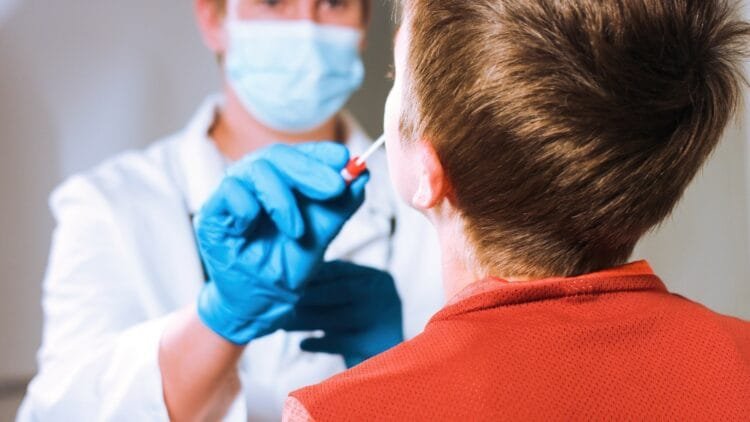The COVID-19 pandemic has altered virtually all aspects of daily life in communities spanning the globe. In the United States, schools canceled in-person instruction in the spring of 2020 to mitigate the spread of the virus. And while many districts have reopened completely or are providing hybrid instruction, there are still some in which students are being taught entirely online. As schools reopen and struggle to remain open amid a global pandemic, changes are taking place daily.

Source: NVeresk/Shutterstock.com
In the coming months and even years, it is likely that new implementations aimed at reducing COVID risk in schools will continually be made in schools across the country. Ensuring the safety of students and staff alike has become more important than ever before, and schools are taking steps to keep everyone healthy.
Staff members are more frequently using products like antimicrobial laundry detergent to sanitize their workwear, and schools are investing in better ways to monitor health and keep classrooms clean. Keep reading to discover a few more implementations we are likely to see in schools in the coming months and years.
Sanitation Stations
Most often, students wash their hands in restrooms and use hand sanitizer when washing isn’t an option. As the pandemic rages on, though, hand hygiene is more important than ever before. As a result, more and more schools are installing sanitation stations that provide additional facilities for handwashing.
Mobile wash stations can be installed virtually anywhere and make it much easier for students to wash their hands frequently. Because they don’t need to be plumbed in, they are much simpler to add to classrooms than traditional sinks.
Many schools are also installing sanitation stations that dispense hand sanitizer. These stations are often motion-activated so students don’t have to touch them for the sanitizer to be dispensed. Installing this type of sanitation station is a cost-effective means of keeping students’ hands clean, so expect to see more and more of them in schools and classrooms.
On-Site COVID Testing

Source: 24K-Production/Shutterstock.com
Daily health screenings are already taking place in many school districts across the country. Checking students’ temperature and asking if they are experiencing any symptoms prior to entering the school only does so much, though. These brief checks don’t tell the full story of a student’s health. Since symptoms vary from one person to another, it’s possible for COVID-positive people to pass such screenings.
In the coming months, expect to see on-site COVID testing in schools. And in areas where on-site testing is not possible due to staffing or budgetary constraints, schools will likely partner with local testing sites to make tests more accessible to students and faculty members.
Modified Attendance Policies
Attendance policies have long been in place to ensure that students are in school to learn what they need to do. However, those policies are being modified in light of the pandemic. With experts recommending that anyone who has potential COVID symptoms quarantine at home, past policies would serve to punish students for following guidelines.
To help keep students on track while ensuring safety and slowing the spread of the virus, most districts have relaxed their attendance policies or are making exceptions for students who have the virus or have been exposed to COVID-19.
Students and parents also have more choices regarding whether to attend school in person. In most areas, it is up to each student’s parents to decide whether the child will attend school in person or participate in online instruction instead. Some areas are allowing students to seamlessly switch back and forth to in-person and online instruction, too, without any impact on their attendance record.
Layout Changes

Source: Suchawalun Sukjit/Shutterstock.com
Overcrowded classrooms are becoming more and more a thing of the past, thanks to social distancing requirements. Studies have shown that social distancing helps prevent the spread of illnesses, and it has become a hot topic as schools have worked to reopen.
The CDC recommends maintaining six feet of distance between individuals who do not live in the same household. This means that desks, chairs, and tables all need to be spaced farther apart. Classroom layouts are being changed to accommodate social distancing. When there is not adequate space for this, students are being kept in consistent groups to minimize exposure to other people.
Layouts are also being modified in cafeterias and other areas inside schools to make room for social distancing. Over the coming months, such changes will continue to be made in an effort to slow the spread and keep schools open.
Staff Dress Code Changes
Many school districts are relaxing their dress codes for staff members. Instead of requiring them to dress in business casual attire, many districts are asking staff members to wear scrubs to work. Though most commonly worn by healthcare professionals, wearing scrubs offers many benefits in educational settings.
Garments like mens’ scrub jackets can be washed and sanitized in hot water, and they are designed to be inhospitable to viruses and bacteria. They are also easy to change in and out of in the event of being exposed to COVID-19.
When laundered using antimicrobial detergent, scrubs can be sanitized much more efficiently than some other types of clothing. While seeing a teacher wearing scrubs instead of a dress or a shirt and tie may take some getting used to, this type of work attire is likely to become increasingly common in American schools.
Conclusion
As the coronavirus pandemic is an evolving situation, changes are constantly taking place in schools throughout the United States and around the world. There will likely be many new implementations throughout the coming months and beyond — even as more and more people get vaccinated against COVID-19. Even with vaccines, it’s important we prevent the spread with distancing and precautions in schools. Ending the pandemic is on nearly everyone’s mind, but we should all be prepared for our lives to look different from what we’re used to for a long while to come.

